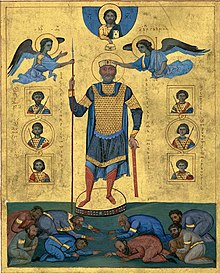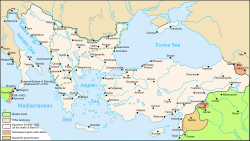จักรพรรดิเบซิลที่ 2
| จักรพรรดิเบซิลที่ 2 | |
|---|---|
| จักรพรรดิแห่งชาวโรมัน | |
 | |
| จักรพรรดิแห่งจักรวรรดิโรมันตะวันออก | |
| ครองราชย์ | 10 มกราคม ค.ศ. 976–15 ธันวาคม ค.ศ. 1025 |
| ราชาภิเษก | 22 เมษายน ค.ศ. 960 ในฐานะรองจักรพรรดิ |
| ก่อนหน้า | จอห์นที่ 1 |
| ถัดไป | คอนสแตนตินที่ 8 |
| ประสูติ | ป. 958 คอนสแตนติโนเปิล, จักรวรรดิโรมันตะวันออก |
| สวรรคต | 15 ธันวาคม 1025 (อายุ 66–67) คอนสแตนติโนเปิล, จักรวรรดิโรมันตะวันออก |
| ฝังพระศพ | โบสถ์เซนต์จอห์น์เดอะเทรโอโลเกียน, คอนสแตนติโนเปิล (ปัจจุบันคืออิสตันบูล) |
| กรีก | Βασίλειος |
| ราชวงศ์ | มาซิโดเนีย |
| พระราชบิดา | จักรพรรดิโรมานอสที่ 2 |
| พระราชมารดา | เทรโอปาโน |
| ศาสนา | คริสตจักรคัลเซดอน[a] |
จักรพรรดิเบซิลที่ 2 (กรีก: Βασίλειος Πορφυρογέννητος, อักษรโรมัน: Basileios Porphyrogennētos; [b] ป. 958 - 15 ธันวาคม ค.ศ. 1025) ได้รับสมญานามว่า ผู้ปราบบัลการ์ (กรีก: ὁ Βουλγαροκτόνος, อักษรโรมัน: ho Boulgaroktonos), [c] เป็นจักรพรรดิองค์อาวุโสแห่งจักรวรรดิโรมันตะวันออก ที่ครองราชย์มาเป็นระยะเวลาเกือบ 50 ปี (10 มกราคม ค.ศ. 976 - 15 ธันวาคม ค.ศ. 1025) เคยเป็นพระสหายร่วมงานกับจักรพรรดิองค์อื่น ๆ ตั้งแต่ปี ค.ศ. 960 เขาและคอนสแตนตินซึ่งเป็นน้องชายของเขา [d] ถูกได้รับการเสนอชื่อให้เป็นผู้ปกครองร่วมก่อนที่โรมานอสที่ 2 ผู้ซึ่งเป็นบิดาจะสวรรคตในปีค.ศ. 963 บัลลังก์ตกเป็นของนายพลสองคนอย่าง นิกโฟโรส โพกัส (ป. 963–969) และ จอห์น ทซิมิสเคส (ป. 969–976) ก่อนที่เบซิลจะขึ้นเป็นจักรพรรดิองค์อาวุโส เบซิล เลกาเปนอส ลุงผู้ทรงอิทธิพลของเขา ได้เป็นผู้ปกครองโดยพฤตินัย ของจักรวรรดิโรมันตะวันออกจนถึงปีค.ศ. 985 [e] เบซิลครองอำนาจเป็นเวลา 40 ปี

หมายเหตุ[แก้]
- ↑ คริสตจักรออร์ทอดอกซ์ตะวันออก และคริสตจักรโรมันคาทอลิก เคยอยู่ภายใต้การร่วมกัน ในฐานะคริสตจักรคัลเซดอน จนกระทั่งเกิดศาสนเภทตะวันออก-ตะวันตก เมื่อวันที่ 16 กรกฎาคม ค.ศ. 1054[1]
- ↑ Regnal numbers were never used in the Byzantine Empire. Instead, the Byzantines used nicknames and patronymics to distinguish rulers of the same name. The numbering of Byzantine emperors is a purely historiographical invention, beginning with Edward Gibbon in his History of the Decline and Fall of the Roman Empire.[2] In his lifetime and later, Basil was distinguished from his namesake predecessor by the surnames the Younger (กรีก: ὁ νέος, อักษรโรมัน: ho neos) and, most often, the Purple-born (กรีก: ὁ πορφυρογέννητος, อักษรโรมัน: ho porphyrogennetos).[3][4]
- ↑ Basil's blinding of Bulgarian prisoners after the Battle of Kleidion, although it may have been exaggerated, helped give rise to his epithet "the Bulgar Slayer" (กรีก: ὁ Βουλγαροκτόνος, อักษรโรมัน: ho Boulgaroktonos).[5] Stephenson (2000, p. 62) and Magdalino (2003, p. 10) believe the epithet to have entered common usage among the Byzantines at the end of the 12th century, when the Second Bulgarian Empire broke away from Byzantine rule and Basil's martial exploits became a theme of Imperial propaganda. It was used by the historian Niketas Choniates and the writer Nicholas Mesarites, and consciously inverted by the Bulgarian ruler Kaloyan, who called himself "Roman-slayer" (กรีก: Ρωμαιοκτόνος, อักษรโรมัน: Rhomaioktonos).[6]
- ↑ The Roman and Byzantine Empires had a number of rulers named Constantine, many of whom are usually not counted using regnal numbers because they were never senior or sole emperor. Five emperors named Constantine ruled during the Macedonian era: Constantine, the eldest son and co-ruler of Basil I; Constantine VII the Porphyrogenitus; Constantine Lekapenos, a son and co-ruler of Romanos I; Constantine VIII; and Constantine IX Monomachos.[2]
- ↑ Basil Lekapenos' control of power until 985 has caused some historians, such as Antonopoulou, Kotzabassi & Loukaki (2015, p. 274) and Schulman (2002, p. 51) to date Basil II's reign from 985 to 1025.
อ้างอิง[แก้]
- ↑ Sue 2014.
- ↑ 2.0 2.1 Foss 2005, pp. 93–102.
- ↑ PMBZ, Basileios II. (#20838).
- ↑ Stephenson 2010, pp. 66–80.
- ↑ Stephenson 2000, p. 62.
- ↑ Stephenson 2010, pp. 89–96.
